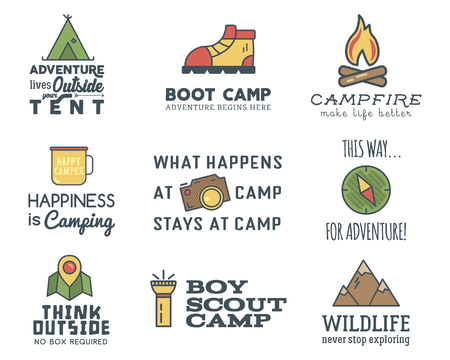1. What is Car Camping and Why It’s Gaining Popularity
Car camping is a flexible and beginner-friendly way to enjoy the outdoors without giving up all the comforts of home. Unlike traditional backpacking, where you carry everything on your back, or RVing, which involves driving a large vehicle equipped with living amenities, car camping means you drive to your campsite and set up camp right next to your vehicle—often sleeping in a tent, in your car, or even under the stars.
Why Car Camping is Trending Across the U.S.
In recent years, car camping has become increasingly popular across the United States. More people are looking for affordable ways to travel, reconnect with nature, and escape their busy urban lives. With minimal gear required and thousands of scenic public lands available—from national parks to state forests—car camping offers an easy entry point into outdoor adventures.
Main Reasons People Love Car Camping:
| Reason | Description |
|---|---|
| Affordability | Car camping is cheaper than staying at hotels or buying an RV. You can use gear you already own and avoid expensive lodging fees. |
| Convenience | You can pack more items in your car compared to backpacking, including food coolers, chairs, and even air mattresses. |
| Accessibility | Many campsites are just a short drive away from major cities, making weekend getaways easy and spontaneous. |
| Flexibility | No need for strict itineraries—just load up your vehicle and go. You can explore multiple locations in one trip. |
| Family & Pet Friendly | Its easier to bring kids and pets along when you have your car nearby for shelter and storage. |
How Car Camping Differs from Other Outdoor Stays
Car Camping vs. Traditional Camping
- Traditional Camping: Often involves hiking into remote areas with all your gear on your back.
- Car Camping: Park right at your site; no long hike required. Great for beginners or those who prefer comfort.
Car Camping vs. RVing
- RVing: Requires owning or renting a recreational vehicle. Comes with built-in beds, bathrooms, and kitchens.
- Car Camping: Much lower cost, more freedom to explore places where RVs cant go. Easier setup and fewer logistics.
If youre looking to explore the outdoors without diving headfirst into full-on backpacking or committing to an RV lifestyle, car camping might be the perfect fit. Its all about balance—comfort meets adventure, flexibility meets simplicity.
2. Essential Gear for a Comfortable Car Camping Experience
When youre heading out on a car camping trip in the USA, having the right gear can make all the difference between a rough night and an enjoyable adventure. Here’s a breakdown of the must-have equipment you’ll need to stay comfortable, organized, and ready for anything nature throws your way.
Tents and Shelter Options
Even though youre camping near or in your vehicle, having a reliable tent is still important. Many campers prefer a ground tent for extra space or a rooftop tent for convenience. Choose based on your vehicle type and comfort preference.
| Type of Shelter | Pros | Cons |
|---|---|---|
| Ground Tent | Affordable, spacious, easy to set up anywhere | Takes up trunk space, may require flat terrain |
| Rooftop Tent | Off-the-ground sleeping, quick setup, integrated mattress | Expensive, affects fuel economy, requires roof rack |
| SUV/Truck Camping Setup | Weatherproof, safe from wildlife, no setup time | Limited space, can get stuffy without ventilation |
Sleeping Systems
A good night’s sleep is crucial when youre camping. Whether you’re sleeping in your car or in a tent, invest in quality bedding. Consider layering for different climates.
- Sleeping Bag: Choose one rated for the coldest temperature you expect.
- Sleeping Pad or Air Mattress: Provides insulation and comfort from the ground or car floor.
- Pillows and Blankets: Bring from home or use compact camp pillows and packable blankets.
Cooking Equipment
One of the joys of car camping is enjoying tasty meals outdoors. A simple cooking setup can go a long way. Make sure to follow Leave No Trace principles and local fire regulations.
Basic Camp Kitchen Essentials:
- Camp Stove or Portable Grill: Propane stoves are reliable and easy to use.
- Cookware: A pot, pan, utensils, cutting board, and knife should cover most meals.
- Cooler or Portable Fridge: Keeps food fresh during multi-day trips.
- Dishes & Utensils: Reusable plates, bowls, forks/spoons—go eco-friendly!
- Water Storage: At least one gallon per person per day is recommended.
- Cleanup Supplies: Biodegradable soap, sponge, dish towel, trash bags.
Campsite Organization Tips
A well-organized campsite makes everything easier—from cooking to packing up. Use bins and storage solutions to keep things tidy and accessible.
Campsite Organization Must-Haves:
- Storage Bins: Categorize gear into kitchen items, bedding, tools, etc.
- Cargo Organizer or Drawer System: Especially helpful in SUVs/trucks for maximizing space.
- Campsite Table & Chairs: For eating and relaxing comfortably at campgrounds without picnic tables.
- Laundry Bags & Dirty Gear Storage: Helps separate clean from used items quickly.
Optional Comfort Extras
If you have space in your vehicle, consider bringing some extras that add comfort and fun to your trip:
- Camp lanterns or string lights for ambiance and visibility at night
- A portable power station to charge devices and run small electronics
- A foldable privacy tent for changing or using a portable toilet/shower system
- An outdoor rug to keep dirt out of your sleeping area or car interior
The right gear will set you up for success on any car camping adventure across the U.S., whether youre exploring National Parks or spending a weekend at a nearby state forest. Take the time to prep before you go so you can focus on making memories under the stars!

3. Choosing the Right Vehicle and Packing Smart
When it comes to car camping in the USA, your vehicle is more than just transportation—its your basecamp. Picking the right vehicle and knowing how to pack efficiently can make or break your adventure. Heres how to set yourself up for success.
Choosing the Right Vehicle for Car Camping
Not all vehicles are created equal when it comes to camping. Depending on your style, group size, and destinations, you’ll want a ride that suits your needs. Heres a quick breakdown of common options:
| Vehicle Type | Pros | Cons | Best For |
|---|---|---|---|
| SUVs | Spacious, AWD/4WD options, flat-folding seats | Lower MPG, limited headroom for sleeping inside | Couples or solo travelers going off-grid |
| Minivans | Roomy interiors, good MPG, stealthy camping option | Less rugged for rough terrain | Families or anyone who wants comfort on a budget |
| Pickup Trucks with Camper Shells | Tons of storage, great for gear-heavy trips | No interior access from cab to bed area | Outdoor enthusiasts with lots of equipment |
| Crossover Vehicles | Fuel-efficient, easy to drive and park | Limited space for sleeping and gear | Weekend warriors or solo campers |
Packing Smart: Space-Saving Strategies
Space is always at a premium when youre living out of your vehicle. These packing tips will help you maximize room and stay organized:
Use Storage Bins and Organizers
Clear plastic bins let you see what’s inside without digging through bags. Label each bin by category—like kitchen supplies, clothes, or tools—for easy access.
Invest in Multi-Use Gear
A collapsible water jug, nesting cookware, and a sleeping bag that doubles as a blanket save tons of space without sacrificing comfort.
Pack Vertically, Not Just Horizontally
Make use of vertical space in the back of your vehicle by stacking bins or using hanging organizers from the headrests.
Keeping Your Ride Organized on Long Trips
Create Zones Inside Your Vehicle
Assign specific areas for sleeping, cooking gear, food storage, and personal items. This helps keep things tidy and easy to find—even after a week on the road.
Daily Reset Routine
At the end of each day, take five minutes to put things back where they belong. It’ll prevent clutter from piling up and make mornings smoother.
Add Hooks and Velcro Strips
Use adhesive hooks or Velcro strips to hang items like lanterns, towels, or hats. It keeps them off the floor and within reach.
Pro Tip:
If youre planning extended stays or traveling through multiple climates, consider a rooftop cargo box. It expands storage without cramping your sleeping area inside the vehicle.
The right vehicle setup and smart packing strategies will turn your car into a cozy home-on-wheels—ready for everything from weekend escapes to cross-country adventures.
4. Top Car Camping Destinations Across the USA
Whether youre a weekend warrior or planning a cross-country road trip, the U.S. offers a wide variety of car camping destinations to suit every kind of outdoor enthusiast. From iconic national parks to quiet, off-the-beaten-path campgrounds, here’s a curated list of scenic and popular spots across different regions.
🏞️ Western U.S.
| Location | State | Highlights |
|---|---|---|
| Yosemite National Park | California | Granite cliffs, waterfalls, abundant wildlife |
| Zion National Park | Utah | Canyon views, hiking trails, red rock formations |
| Crater Lake National Park | Oregon | Deep blue lake, volcanic scenery, peaceful campsites |
🌲 Pacific Northwest Hidden Gems
- Olympic National Forest (WA): Lush rainforests and ocean views with plenty of dispersed camping options.
- Mt. Hood National Forest (OR): Quiet lakeside spots perfect for paddleboarding and fishing.
⛰️ Rocky Mountains Region
| Location | State | Why Go? |
|---|---|---|
| Rocky Mountain National Park | Colorado | Breathtaking alpine scenery and wildlife watching |
| Tetons Backcountry Sites | Wyoming | Lesser-known spots near Grand Teton National Park with stunning mountain backdrops |
🌄 Southwest Desert Favorites
- Sedona (AZ): Red rock desert landscapes with several car-accessible BLM camping areas.
- Big Bend National Park (TX): Remote beauty along the Rio Grande with both developed and primitive sites.
🌳 Midwest Retreats
| Location | State | Main Features |
|---|---|---|
| Pictured Rocks National Lakeshore | Michigan | Lakeside camping with cliffside views and forest hikes nearby |
| Custer State Park | South Dakota | Bison herds, granite peaks, scenic drives through the Black Hills |
🌅 East Coast Escapes
Northeast:
- Acadia National Park (ME): Oceanfront views and mountain hikes all in one spot.
- Catskill Forest Preserve (NY): Great for fall foliage and rustic car camping vibes.
Southeast:
- Great Smoky Mountains National Park (TN/NC): One of America’s most visited parks with easy-access campgrounds surrounded by dense forests.
- Cumberland Island National Seashore (GA): Wild horses, beaches, and peaceful nights under the stars.
No matter where you’re headed across the country, there’s a car camping destination that fits your vibe—whether it’s tranquil lakeside mornings or epic mountain sunsets. Pack up your gear, hit the road, and start exploring!
5. Rules, Safety, and Car Camping Etiquette
Car camping in the USA is all about enjoying the great outdoors while being respectful and responsible. Whether youre camping in a national park, a state forest, or on public land managed by the Bureau of Land Management (BLM), its important to know the rules, follow safety guidelines, and practice good camping manners. Heres what you need to know to keep your trip fun, safe, and stress-free.
Know the Local Regulations
Every campsite has its own set of rules depending on who manages it. Before heading out, check the official website of the park or campground for details on:
- Permits and reservations
- Fire restrictions or bans
- Quiet hours and generator use
- Pet policies
- Maximum stay limits
If youre boondocking (dispersed camping) on BLM or National Forest lands, make sure youre in an area where overnight parking is allowed. Some spots have time limits or seasonal closures.
Leave No Trace Principles
The Leave No Trace (LNT) principles help protect nature so others can enjoy it too. These seven simple guidelines should be part of every car camper’s routine:
| Principle | Description |
|---|---|
| 1. Plan Ahead and Prepare | Know where youre going and what to expect. Pack smart. |
| 2. Travel and Camp on Durable Surfaces | Stick to established roads and campsites. |
| 3. Dispose of Waste Properly | Pack out all trash and leftover food. Use restrooms when available. |
| 4. Leave What You Find | Dont take natural or cultural items like rocks or artifacts. |
| 5. Minimize Campfire Impact | Use existing fire rings and follow local fire rules. |
| 6. Respect Wildlife | Never feed animals; store food securely. |
| 7. Be Considerate of Other Visitors | Keep noise down and give others space. |
Staying Safe While Car Camping
Your safety is key to a great trip. Here are some top tips for staying safe while car camping:
- Weather Awareness: Check the forecast before your trip and prepare for sudden changes in weather.
- Fire Safety: Only build fires in designated areas and fully extinguish them before leaving or going to sleep.
- Food Storage: Use bear-proof containers or store food in your vehicle with windows closed to avoid attracting wildlife.
- First Aid: Bring a basic first aid kit and know how to treat minor injuries like cuts, burns, or insect bites.
- Emergency Plans: Let someone know your itinerary, especially if youre camping off-grid without cell service.
Good Etiquette Makes Camping Better for Everyone
A little courtesy goes a long way at campgrounds where people are sharing space. Here are some common-sense etiquette tips:
- Keep It Quiet: Follow quiet hours (usually around 10 PM–6 AM) to let everyone relax peacefully.
- Tidy Campsite: Don’t spread gear everywhere—keep your site neat.
- No Trespassing: Respect other campers space; don’t walk through their campsites.
- Packing Out Trash: If trash cans are full or unavailable, take your garbage with you.
- Pets Under Control: Keep dogs leashed unless in a designated off-leash area, and always clean up after them.
The more we all do our part, the better the experience will be—not just for us, but for future campers too!


